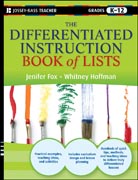
Hundreds of useful ideas for meeting the needs of each child The Differentiated Instruction Book of Lists is the definitive reference for DI for teachers in grades K-12. Ready for immediate use, it offers over 150 up-to-date lists for developing instructional materials, lesson planning, and assessment. Organized into 12 convenient sections, the book is full of practical examples, teaching ideas, and activities that can be used or adapted to meet students' diverseneeds. Coverage includes curriculum design, lesson planning, instructional strategies, assessment, classroom management, strategies by subject area (from Language Arts to Math to Physical Education), new media, etc. Offers an easy-to-use guide that gives quick tips and methods to plan effectively for delivering truly differentiated lessons Filled with helpful DI lists, lesson plans, strategies, assessments, and more Jennifer Fox is the author of the bestselling book Your Child's Strengths The Differentiated Instruction Book of Lists is a hands-on guide for meeting the instructional needs of all students so that theycan reach their full potential. INDICE: About This Resource. The Authors. Acknowledgments. Preface. Introduction. Section One Understanding Differentiated Instruction. List 1.1. A Vision for the Differentiated Instruction Classroom. List 1.2. One-Size-Fits-All Teaching Versus Differentiated Teaching. List 1.3. Small Things That Make a BigDifference. List 1.4. Common Misconceptions. List 1.5. Differentiate the Materials. List 1.6. Differentiate the Task. List 1.7. Differentiate the Homework.List 1.8. Differentiate Checking for Understanding. List 1.9. Differentiate the Outcome List 1.10. Are You Ready for Differentiated Instruction? A Few MoreExamples of What Is Expected. List 1.11. Definitions of Concepts Commonly Associated with Differentiated Instruction. Section Two Teaching with the Individual in Mind. List 2.1. Building Relationships. List 2.2. Strategies to Determine Individual Strengths. List 2.3. Interest Inventories. List 2.4. Planning with Learning Styles in Mind. List 2.5. Multiple Intelligences and Differentiated Instruction. List 2.6. Tips for Raising Students' Comfort Level. List 2.7. Tips to Help Struggling Students. List 2.8. Tips for Motivating All Students. List 2.9. Class Discussion Strategies. Section Three Planning the Differentiated Curriculum. List 3.1. Where to Begin and What to Do. List 3.2. Tips for Keeping Records for Differentiated Lesson Plans List 3.3. How to Create Differentiated Lesson Plans with Blooms Taxonomy. List 3.4. Differentiated Assessments. List 3.5. Curriculum Compacting: Why and How. List 3.6. What Are Authentic Choices? How to Plan with Them. List 3.7. General Planning Tips for the Differentiated Classroom Section Four Most Commonly Used Differentiated Instruction Techniques and How to Use Them. List 4.1. Tiered Lessons. List 4.2. Scaffolding Tools. List 4.3. Project-Based Learning. List 4.4. Learning Contracts. List 4.5. Graphic Organizers. List 4.6. Flexible Grouping. List 4.7. Learning Stations. List 4.8. Rubrics. Section Five Differentiated Classroom Management List 5.1. Arranging the Classroom for Optimal Differentiated Instruction Management List 5.2. Strategies for Differentiated Classroom Management List 5.3. Why Students Misbehave List 5.4. Discipline Strategies List 5.5. Strength-Based Discipline: An Individualized Approach List 5.6. Examples of Strength-Based Versus Deficit-Based Labels List 5.7. Classroom Management and Parental Communication Tips Section Six Roles and Responsibilities. List 6.1. Classroom Teacher List 6.2. Students List 6.3. Administrators List 6.4. Parents List 6.5. Support Staff Section Seven Using Differentiated Instruction Techniques at Different GradeLevels. List 7.1. Kindergarten. List 7.2. Grades 15. List 7.3. Middle School.List 7.4. High School. Section Eight Strategies for Differentiating Language Arts. List 8.1. What Exemplary Reading Teachers Do to Differentiate Reading Instruction. List 8.2. Strategies to Improve Reading. List 8.3. Tips for Differentiating Small-Group Reading Instruction. Lis
- ISBN: 978-0-470-95239-9
- Editorial: John Wiley & Sons
- Encuadernacion: Rústica
- Páginas: 288
- Fecha Publicación: 12/08/2011
- Nº Volúmenes: 1
- Idioma: Inglés
